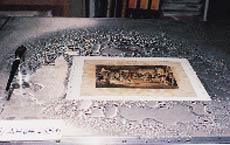Liu Wai-sum, Angela
Former Assistant Curator I (Conservation) Painting, Conservation Office
2008
| |
The Museum of Art has a collection of chromolithographs which were printed in London and dated back to the 1800s. At the time of collection, unsightly brown stains were extensively found on one of the items. As the stains had masked much of the details in the image area (see Diagram 1), the subject curator reckoned it necessary to receive conservation treatment before further study and research could be conducted on the print. The brown colouration was found to be a result of some chemical deterioration, which happened on the cellulose fibre of the paper substrate, due to its previous unfavourable storage condition. |
| |
A series of preliminary tests were therefore conducted to determine an appropriate mode of treatment. Removal of loose surface dirt followed. The print was then humidified before it was "washed" with deionized water, under mild vacuum, on a suction table to remove the water soluble acidic substances trapped between the paper fibres. The stain was much reduced after repeated washings, but the details of the print were still not fully recovered (see Diagram 2).
|
| |
After discussion with the subject curator, the print was then treated with a mild, weakly basic oxidizing agent (3% hydrogen peroxide solution buffered with ammonia to pH8). The result of the chemical treatment was satisfactory. The details of the print were fully recovered amongst other artistic and historic merits (see Diagram 3).
|
Many of us collect pictures or prints at home, which may be of great sentimental value and historical significance. Not only are they your most-valued treasures, they can also be the "witnesses of history" which are attached with significant cultural or historical importance. As "prevention is always better than cure", it is desirable to take due preventive measures for their long-term keeping before too late. As a general guideline, they should be kept in a clean, well-ventilated and pest-free environment where the ambient light levels can be controlled. Furthermore, they must be handled with care and if possible, put on clean cotton gloves before handling them. If framing and mounting are considered necessary for objects, always choose products with archival quality and ensure that the processes are reversible. Hong Kong has inherited a cultural legacy which is unique to itself. It is important that these cultural properties are properly cared for so that Hong Kong's characteristic culture can be preserved for posterity. Conservation is a primary function of museums, which serves to preserve the cultural property through preventive and interventive conservation. Preventive conservation emphasizes on preserving the physical condition of cultural property through the control of environmental parameters, biological activities and human factors; whereas interventive conservation addresses the treatment needs of individual items and the execution of treatment plans. Conservation is therefore a long-term commitment, which requires conservators to provide proper care for the cultural property with life-long responsibilities. On the long way to help save our irreplaceable cultural heritage, we look forward to your unfailing support.






